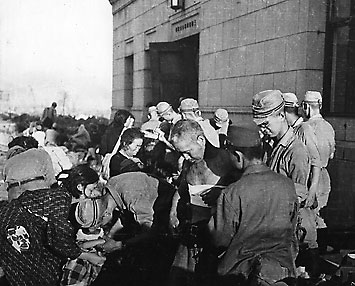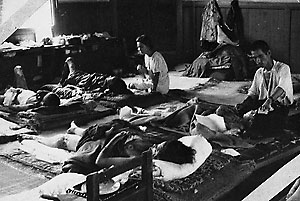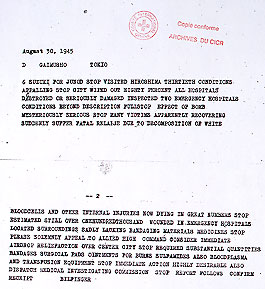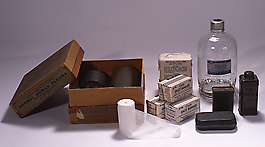Rescue from the Ashes
The massive A-bomb destruction rendered all of Hiroshima's anti-air raid and rescue systems useless.
Immediately after the bombing, the Army Marine Headquarters (commonly known as "Akatsuki Corps") stationed in Ujina took the lead role in rescue activities. Those doctors who survived and rescue teams from Kure, Hatsukaichi, and other areas around Hiroshima came to help. The rescue effort suffered from a drastic shortage of medicines, bandages and other medical supplies. Thousands died who might have been saved by adequate first aid.
Near the end of August, Dr. Marcel Junod, head of delegation of the International Committee of the Red Cross in Japan, learned of the terrible tragedy still unfolding in Hiroshima. He quickly arranged the delivery of medical supplies, which arrived in early September.
 6 Relief squad providing treatment to many people August 7, 1945 Yokogawa-cho 3-chome In front of Hiroshima City Credit Union Headquarters 1,700m from the hypocenter Photo by Mitsugi Kishida Courtesy of Teppei Kishida Since the A-bomb destroyed the air defense and relief aid systems, first aid treatment directly after the bombing was mainly provided by the Akatsuki Corps, attached to the Army Marine Headquarters, that had received relatively little damage. Relief squads dispatched from within and around the prefecture worked on assisting and treating the injured. |
 7 Temporary relief station set up along a river August 8, 1945 Moto-machi 1,150m from the hypocenter Photo by Yotsugi Kawahara Since nearly all the hospitals and medical treatment centers were destroyed, relief stations were set up in places that survived the fires where A-bomb survivors gathered such as steel-reinforced concrete structures, dry riverbeds and the foot of bridges. |
 8 Many people worked hard to nurse the wounded August 1945 Dambara-yamasaki-cho First Elementary School 2,600m from the hypocenter Photo by Army Marine Headquarters Donated by Keisuke Misonoo First aid treatment was provided not only by doctors and nurses but also by local civil defense teams, women's associations and other groups who helped out by caring for the wounded. Whole families were seen searching for missing relatives and earnestly nursing the wounded. |
 9 A child suffering from his wounds August 1945 Dambara-yamasaki-cho First Elementary School 2,600m from the hypocenter Photo by Army Marine Headquarters Donated by Keisuke Misonoo |
 |
10 Telegram sent by Fritz Bilfinger to Dr. Marcel Junod (copy) Dated August 30, 1945 Courtesy of International Committee of the Red Cross Archives |
 12 Dr. Marcel Junod in Japan Courtesy of Benoit Junod Dr. Marcel Junod, head of delegation of the International Committee of the Red Cross arrived in Japan on August 9, 1945. Upon receiving a report about the devastation caused by the bombing from Fritz Bilfinger, who had come to Hiroshima at the end of August in order to conduct a survey on prisoner treatment by the allied forces, Dr. Junod negotiated with the General Headquarters of the Allied Forces who allowed him to immediately and personally deliver medical supplies to Hiroshima. |
|

|
11 Delivery of medical supplies Donated by Masaru Matsunaga |
